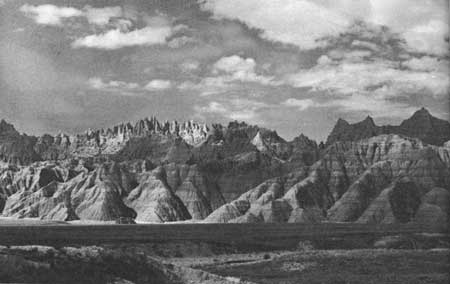|
BADLANDS National Park |
 |
Present Climate
The climate of the badlands area is characterized as typically continental and arid. Summers are short and hot, and winters long and cold. Annual precipitation averages 17 inches; most of it occurs during the spring and early summer. Precipitation is irregular, and long periods of drought may be expected. Temperatures vary from a low of -30d⪚, or colder, in January or February, to over 100° in July and August. Those extremes seldom last more than 1 or 2 days. Winter precipitation is mostly snow, but, because of gusty winds, large areas are blown free of snow and sizeable drifts accumulate in road cuts and protected gullies. The transition from winter to summer is usually rapid, so the period of spring lasts but a few weeks.
 A typical badlands scene, near Norbeck Pass |
Summers are characterized by hot and frequently windy days which may see duststorms develop in the exposed badlands formations or the neighboring cultivated fields. Nights are comparatively cool. From time to time rather violent, but short, hailstorms occur, and these speed up erosion. The infrequent summer rains run off rapidly and within a few minutes the gullies may contain raging torrents that disappear shortly after the rain stops.

|

|
| NPS History | History & Culture | National Park Service | Contact |
|
Last Modified: Sat, Nov 4 2006 10:00:00 pm PST |


